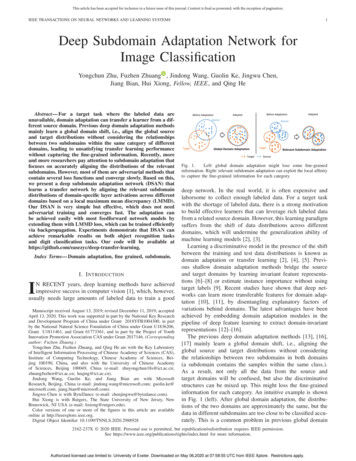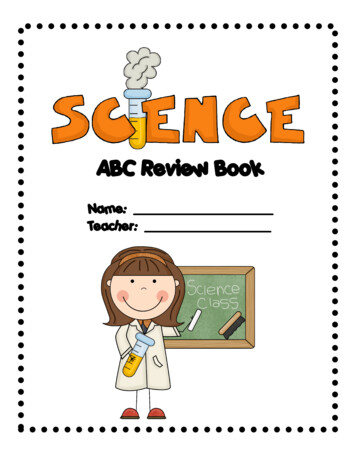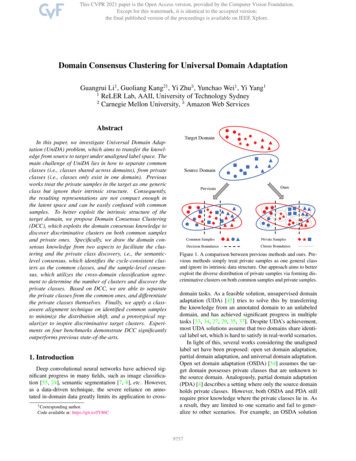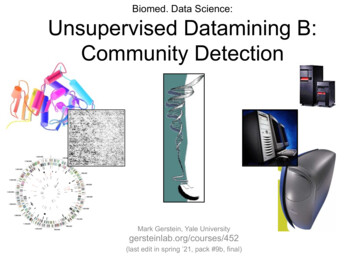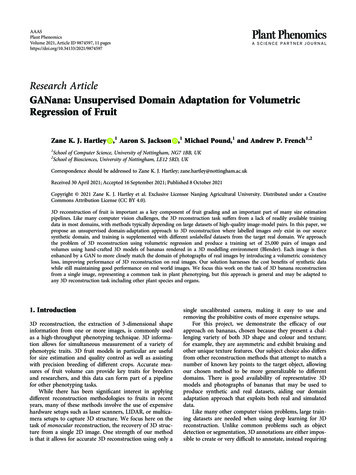
Transcription
AAASPlant PhenomicsVolume 2021, Article ID 9874597, 11 pageshttps://doi.org/10.34133/2021/9874597Research ArticleGANana: Unsupervised Domain Adaptation for VolumetricRegression of FruitZane K. J. Hartley ,1 Aaron S. Jackson ,1 Michael Pound,1 and Andrew P. French1,212School of Computer Science, University of Nottingham, NG7 1BB, UKSchool of Biosciences, University of Nottingham, LE12 5RD, UKCorrespondence should be addressed to Zane K. J. Hartley; zane.hartley@nottingham.ac.ukReceived 30 April 2021; Accepted 16 September 2021; Published 8 October 2021Copyright 2021 Zane K. J. Hartley et al. Exclusive Licensee Nanjing Agricultural University. Distributed under a CreativeCommons Attribution License (CC BY 4.0).3D reconstruction of fruit is important as a key component of fruit grading and an important part of many size estimationpipelines. Like many computer vision challenges, the 3D reconstruction task suffers from a lack of readily available trainingdata in most domains, with methods typically depending on large datasets of high-quality image-model pairs. In this paper, wepropose an unsupervised domain-adaptation approach to 3D reconstruction where labelled images only exist in our sourcesynthetic domain, and training is supplemented with different unlabelled datasets from the target real domain. We approachthe problem of 3D reconstruction using volumetric regression and produce a training set of 25,000 pairs of images andvolumes using hand-crafted 3D models of bananas rendered in a 3D modelling environment (Blender). Each image is thenenhanced by a GAN to more closely match the domain of photographs of real images by introducing a volumetric consistencyloss, improving performance of 3D reconstruction on real images. Our solution harnesses the cost benefits of synthetic datawhile still maintaining good performance on real world images. We focus this work on the task of 3D banana reconstructionfrom a single image, representing a common task in plant phenotyping, but this approach is general and may be adapted toany 3D reconstruction task including other plant species and organs.1. Introduction3D reconstruction, the extraction of 3-dimensional shapeinformation from one or more images, is commonly usedas a high-throughput phenotyping technique. 3D information allows for simultaneous measurement of a variety ofphenotypic traits. 3D fruit models in particular are usefulfor size estimation and quality control as well as assistingwith precision breeding of different crops. Accurate measures of fruit volume can provide key traits for breedersand researchers, and this data can form part of a pipelinefor other phenotyping tasks.While there has been significant interest in applyingdifferent reconstruction methodologies to fruits in recentyears, many of these methods involve the use of expensivehardware setups such as laser scanners, LIDAR, or multicamera setups to capture 3D structure. We focus here on thetask of monocular reconstruction, the recovery of 3D structure from a single 2D image. One strength of our methodis that it allows for accurate 3D reconstruction using only asingle uncalibrated camera, making it easy to use andremoving the prohibitive costs of more expensive setups.For this project, we demonstrate the efficacy of ourapproach on bananas, chosen because they present a challenging variety of both 3D shape and colour and texture;for example, they are asymmetric and exhibit bruising andother unique texture features. Our subject choice also differsfrom other reconstruction methods that attempt to match anumber of known key points to the target object, allowingour chosen method to be more generalizable to differentdomains. There is good availability of representative 3Dmodels and photographs of bananas that may be used toproduce synthetic and real datasets, aiding our domainadaptation approach that exploits both real and simulateddata.Like many other computer vision problems, large training datasets are needed when using deep learning for 3Dreconstruction. Unlike common problems such as objectdetection or segmentation, 3D annotations are either impossible to create or very difficult to annotate, instead requiring
2additional data to be captured using specialised tools. Ittherefore quickly becomes expensive to produce trainingdatasets, particularly at scale, outside of the most commonproblem spaces such as human pose or road features andvehicles.3D reconstruction is, however, an important task inmany areas and has been applied to fields including medicalimaging, 3D mapping of human faces and bodies [1, 2],simultaneous localisation and mapping (SLAM) [3] for usein autonomous vehicles and augmented reality, and mapping the shape of various common objects for use in virtualenvironments [4]. Obtaining high-quality models can bedifficult, and this 3D geometry may be encoded in manydifferent ways, such as point clouds [5], 3D meshes, andvoxel representations [6].This difficulty in capture and a lack of cohesion betweendatasets make training from limited data a key challenge.This paper specifically focuses on a monocular approachvia a volumetric regression network, lowering the cost andcomplexity of performing accurate 3D reconstruction, whileour approach remains applicable across a wide number ofdomains.In this paper, we propose a novel framework for trainingDeep Convolutional Neural Networks to accurately reconstruct 3D volumes of fruit and achieve a high level ofaccuracy while removing the hurdle of expensive data collection. Our approach frames the problem as one of unsupervised domain adaptation, using synthetic data from 3Dmodelling to avoid the difficult task of collecting groundtruth 3D models with corresponding photographs of realbananas. Our model has two goals, first to transfer imagesfrom a synthetic domain to a real domain, while preservingthe 3D geometry of the object in the image, and second toextract a volume of the object from the image. Unlike otherworks, which treat these as separate problems, our architecture is trained in an end-to-end fashion and is designed to beapplicable to the widest variety of subject matter.1.1. Motivations. Our experiments were motivated by theaim of greatly reducing the cost of solving monocular 3Dreconstruction problems using deep learning, where handannotation is not feasible and existing training datasets arescarce. Plant phenotyping comprises a wide variety of imagesubjects upon which phenotyping methods are applied. Thismakes problems of limited training data especially acute, sothe field benefits greatly from methods such as ours thatovercome this data scarcity problem.A goal of our method was to make use of extensivelibraries of 3D models now freely available from onlinesources. Leveraging this new source of data for deep learningis a promising solution to the data scarcity problem. Photorealistic models created for use in film, video games, andother renders can then be reused for any number of computer vision tasks. In our experiments, we have applied ourmethod to the 3D reconstruction of bananas; however, ourapproach includes no domain-specific design choices andcould be applied to any number of different objects so longas a number of accurate 3D models of a particular subjectwere available.Plant PhenomicsIn summary, our main contributions are as follows:(1) We demonstrate a novel architecture for unsupervised domain adaptation and 3D reconstructionfrom single views. Our approach is low cost, avoiding expensive acquisition of real 3D scans(2) We show that good performance can be achieved on3D reconstruction of real images using only synthetic volumes, examples of our output can be seenin Figure 1(3) We release all code used in our pipeline, includingscripts for the creation of our synthetic renderingsthrough to training a volumetric regression network(VRN) with our created datasets(4) Finally, we make available our dataset of 25,000 synthetic banana images and their matching groundtruth volumes on our project websiteThis paper will begin by giving an overview of closelyrelated work in Section 2 before describing the materialsand methods in detail in Section 3. We present our resultsin Section 4 and give an analysis of our results as well asdiscuss limitations in Section 5.2. Related WorkThis section examines related works in the fields of volumetric regression, generative adversarial networks, and domainadaptation of synthetic images.2.1. 3D Reconstruction. While a full review of all literature on3D reconstruction is beyond the scope of this paper, it isworthwhile noting a few popular methods. Application iswide and varied, for example, 3D reconstruction of bloodvessels [7], multiview building reconstruction [4], facereconstruction [8], and view synthesis [9]. In particular, thiswork builds upon previous work for 3D face and bodyreconstruction using volumetric regression [1, 6], in whichthe shape of the object is encoded using voxels directly output by a deep network. Volumetric regression constrains theproblem to a single domain, where both input and outputare spatial, avoiding the need to learn a mapping from imageto Euclidean or some PCA space. Volumetric regression hassince been extended and refined to work more reliably ongeneral human poses, such as in PIFuHD [2]. PIFuHD alsodemonstrates good performance at estimating 3D geometryfor the nonvisible parts of the body.2.2. Plant Phenotyping. Phenotyping refers to a collection oftasks that accurately measure quantifiable traits of plants.Being able to efficiently measure plant traits at scale aidsthe development of new crops and agricultural techniques;this has gained importance given both the climate crisisand the increasing global population. Image-based measurement of plant traits has become ubiquitous, helping withunderstanding environmental impacts on plants, as well asaiding breeding programs and production of crops. Someimportant works on plant phenotyping include the
Plant Phenomics3Figure 1: Results of our volumetric regression network. Output volumetric banana models resting on 2D input images.prediction of plant stresses [10], detection and segmentationof plants from aerial photography [11], and leaf or plantorgan counting [12].3D reconstruction of plant matter is important in solving a number of core tasks including growth measurementand yield estimation such as seen in work by Moonrintaet al. [13]. Jadhav et al. also use 3D reconstruction to helpwith the grading of fruit, with emphasis put on the importance of accurate reconstruction of arbitrary shapes [14].Similarly, 3D reconstruction has been used to map thegeometry of plant shoots, another common phenotypingtask [15].We are not aware of any methods which attempt to do3D reconstruction from a single 2D image in the plant phenotyping space. Monocular approaches such as structurefrom motion have been used such as in Jay et al. [16]; however, these approaches require a sequence of frames insteadof a single image as we use in our work. Beyond traditionalRGB images, Wang and Chen [5] demonstrate fruit reconstruction using a Kinect sensor, while Feldmann et al. [17]perform shape estimation in strawberries using a turntablesystem to capture multiple images of a strawberry rotatingon a calibrated spindle. Yamamoto et al. use an RGB-depthcamera to generate 3D point clouds of apples by combiningdepth and RGB data [18]. Finally, Paulus reviews a numberof works that use different laser scanning devices to capturepoint clouds for plant phenotyping [19].2.3. Generative Adversarial Networks. Generative adversarialnetworks (GANs) are a form of deep learning in which competing networks are trained together. Although applicationsvary, GANs are commonly used to generate images. Theoriginal GAN framework included a generator which created new images from random noise and a discriminatorwhich learned to distinguish images from a training setand those produced by the generator [20]. Since then,this framework has been adapted to many new problems,such as image generation [21], image to image translation[22, 23], and unsupervised recognition tasks [24]. In particular, DCGAN [21] is a popular model used for generatinghigh-resolution realistic images from noise. DCGAN worksacross multiple domains, showing results for generation ofboth faces and bedrooms.Conditional GANs, such as Pix2Pix [22], instead learn toproduce images between two specific domains, such as thegeneration of city scenes from corresponding segmentationmasks. Similarly, CycleGAN [23] also allows for domaintransfer between both the target and source domains usingunpaired images. CycleGAN uses a pair of generators anddiscriminators, which transform images between sourceand target domains in a cyclic manner. By ensuring imagescan be recreated in both directions, we ensure that animage’s content is preserved while changing the imagedomain. We use CycleGAN as the backbone of our ownarchitecture. More recently, SinGAN [25] demonstrated thata distribution can be learned from a single image and can beused for a number of varied image manipulation tasks suchas harmonization and paint-to-image.2.4. Domain Adaptation. Domain adaptation is a field ofmachine learning, related to transfer learning, that focuseson solving the domain shift problem in which a networktrained to solve a task in one data distribution cannot generalize well on another similar distribution. A common benchmark for these problems is the popular character sets such asMNIST, USPS, and SVHN, which appear visually similar butare challenging for networks to generalize between [26].More challenging tests include the office 31 dataset [27],which contains images of common objects from Amazon,webcam, and DSLR domains as well as VisDA [28] whichfocuses on simulation-to-reality shift for classification andsegmentation tasks.Unsupervised domain adaptation refers to problemswhere no labelled examples of the target domain are available [29]. In this case, a model must learn to make predictions based on the deep domain invariant features relevantto the task being solved. A number of recent approachesuse CycleGAN-like models for pixel-level domain adaptation of synthetic images, similar to our own work. Muelleret al. introduced a geometric consistency loss to CycleGANwhich focuses the generator on maintaining the same 2Dgeometry, while converting from the synthetic to realdomain [30]. Their work differs from ours in that they separate the task of bridging the synthetic to real gap from thetask they were trying to solve, whereas we combine the taskin a single model that can be trained end to end. Muelleret al.’s work [30] is very similar to the work of [31] wherethey introduce the semantically consistent CycleGAN, whichalso uses segmentation masks to ensure the 2D shapes of different object are maintained by the generator; further examples can be seen in [32, 33].The work of Shrivastava et al. shows a GAN model calledSimGAN that uses a pairing of a refiner and discriminator toenhance images of synthetic eyes. Their method uses a selfregularization term to maintain gaze direction while enhancing synthetic data to photorealistic quality [34]. SimGAN
4was also used by Liu et al. and applied to the problem ofhuman pose recognition and demonstrated state-of-the-artresults [35].3. Materials and MethodsIn this section, we describe our approach to the problem ofgenerating 3D volumes via unsupervised domain adaptation:in particular, how we crafted our datasets and selected thearchitecture of our model. In addition, we describe theexperiments we conducted in order to test the efficacy ofour proposed architecture.3.1. Training Dataset. To train our model, we utilised twodifferent datasets. The first is a collection of 25,000 imagesof synthetic bananas created in Blender [36] by rendering5 master 3D banana models from freely available onlinesources (links to these will be provided on our project webpage). Each model was chosen for its perceived realism, withmore importance given to 3D geometry than to texture.These 5 models were then modified by scaling randomlyalong each axis to between 0.6 and 1.0 of their original size,followed by random in-plane rotation to create 5000 variations of each. We used the original provided textures forall captures of each master Banana; however, we adjustedthe brightness of the light source between 0.5 and 1.5 timesour default value, as well as adjusting some values of specular reflection to increase image variety. Renderings were captured of the augmented models, along with the randomtransformation parameters used.The corresponding meshes were then used to create 3Dvolumes under the same transformations and were savedinto an HDF5 file for input into PyTorch. For each rendering, a randomly selected image from the COCO dataset[37] was used as a background image, increasing variety inthe training set and encouraging the generator to ignorethe background. Augmentation and rendering were performed automatically in Blender, with volumetric groundtruth produced in python. All required resources to adaptthis pipeline to new datasets and domains will be releasedwith this paper.Our second dataset, consisting of real images, is a collection drawn from three sources. First, images were takenfrom the dataset [38] originally used for ripeness classification networks. Second, the “Top Indian Fruits” dataset contains many images of bananas in various states of ripenessand health [39]; from this, we selected only the examplesof healthy bananas and discarded the associated per-imageripeness and quality labels. Finally, we collected additionalimages ourselves, allowing us to add images with more variations in lighting and angle. To further increase the varietyin our dataset, these images were also augmented withscaling, flips, and rotations to generate 25,000 differentexamples.3.2. Voxelisation Procedure. The rendering process saves theapplied rotation and projection matrix with each bananarendering.Plant PhenomicsIn order to bring the 3D model into alignment such thatit may be voxelised, we first apply the rotation transformation, followed by projection transformation. The projectionmatrix destroys depth information in the Z axis with respectto the image plane. We recover this by using the standarddeviation of the 2D axes, before and after the projection step,as a scaling factor for the Z axis. The standard deviation of xand y is used because it is invariant to any translation whichmay have been applied during projection. More concretely,where M and M proj are the unprojected and projectedmeshes, respectively, of x, y, z coordinates, !std M proj,yM 2 std M proj,x : M proj,z 2stdðM x Þstd M yð1ÞVoxelisation is performed by tracing rays through eachplane, x, y, and z to produce three intermediate volumes.These are combined into a single 3D volume by findingall voxels that intersect at least two of the intermediatevolumes. This approach reduces artefacts but is slightlyslower than performing voxelisation from a single plane(we use Adam Aitkenhead’s implementation, available nge/27390mesh-voxelisation). Our final volumes have a resolution of256 256 128.Higher depth resolution is unnecessary in this problemdomain.3.3. Volumetrically Consistent CycleGAN. Our goal is to trainour end-to-end network to produce a 3D reconstruction ofobjects from the images in the real domain. We extend aCycleGAN implementation [23], shown in Figure 2, to perform unpaired image-to-image translation between real andsynthetic images.Our novel addition here is a VRN that performs 3Dreconstruction on the output of the synthetic to real generator. We evaluated a number of models for this task, including U-Net [40] and stacked hourglass models shown in [6],and found that a modified U-Net implementation achievedthe best performance in early experiments. We use standardspatial convolutions throughout the network and reconfigure the U-Net to use three downsampling layers followedby three upsampling layers. Comparing this loss againstthe true volume of the synthetic image gives us our volumetric consistency loss (VC loss), for which we selected binarycross entropy (BCE). This loss is applied first to the generator, which ensures that the 3D structure of the object ispreserved when changing the domain of the image and additionally the U-Net. The VC loss is given a weight of 1.0, relative to all CycleGAN weights which are given their defaultvalues. This value was determined empirically, though further fine tuning may improve time taken for convergence.It has been shown that CNNs trained on purely syntheticdata do not generalise well onto real images [6]. Large performance increases can be achieved by including a smallfraction of real training data [41]. Our approach extends thisidea by requiring only labelled synthetic data supplemented
Plant enerator(real/synth)TurerealCycleGANFigure 2: The proposed volumetrically consistent CycleGAN (VCC) using our real banana dataset as a target.with different datasets of unlabelled real photographs asinput.3.4. Experiments(1) VRN Trained with Synthetic Data Only. Here, weestablish a baseline in terms of performance, i.e.,what level of performance we can achieve on realimages when trained only on synthetic renders.Synthetic images have been successfully leveragedin many domains, but the domain gap betweensynthetic and real images often leads to poorgeneralisation.(2) VRN Trained on CycleGAN Images. We evaluate theperformance of the VRN on real images, when synthetic training images have first been refined to lookmore realistic. CycleGAN is trained to translate thesynthetic images into the target domain of realimages which are then used to train our VRN ascarried out in experiment 1.(3) GANana VRN. GANana combines the VRN andCycleGAN in a single model, shown in Figure 2, thatcan be trained end to end. Images are refined by theCycleGAN at the same time as our VRN is trained toextract a 3D volume. The approach taken byGANana ensures that refined images preserve thehigh level structural features necessary for volumetric reconstruction while simultaneously closing thedomain gap between the two sets of images.(4) GANana VRN using PASCAL VOC. In this experiment, we use the same architecture from experiment3 but replace our real banana dataset described inSection 3.1 with unlabelled images from the PASCAL VOC dataset. We hypothesised that a widerrange of images from the real domain may compensate for using images that do not match the particular subject of our source domain and, if so, reducethe need to build a domain-specific dataset.(5) GANana VRN using Gaussian Noise. For this test, wereplace our target domain dataset with randomnoise. We hypothesise that this will force our generator to transform our image almost entirely intonoise, maintaining only the high level featuresneeded to regress the banana. By excluding imagesfrom the target domain, we prevent the model fromperforming domain adaptation, and any improvement on our baseline score can be attributed to augmentation. Unlike our previous experiments, in thisexample, losses from the VRN and CycleGAN will,we hypothesise, be sufficiently opposed to each othersuch that it will be impossible to produce goodresults.(6) GANana VRN using Synthetic Target. In our finalexperiments, we train on pairs of identical imagesfrom our synthetic dataset as both the source andthe target domain. By keeping the source and targetdomains the same, CycleGAN is no longer encouraged to transform input images, as any transformation made by the generator can only make eachimage differ from the target. Instead, we hypothesisethat it will apply subtle augmentations to each image,improving robustness of our VRN while beingprevented from significantly altering the high levelfeatures of each image. Increased variability of theinput data means the VRN in our model must bemore resilient to augmentations produced by thegenerator, which may enable it to perform well onimages in our target domain. In this sense, we canconsider the goals of our CycleGAN and VRN tobe better aligned, which we believe will improveperformance.3.5. Testing Dataset. In order to test our method, we builtour own test dataset comprising 15 real banana models withassociated 3D ground truth. Images were captured using thephotogrammetry app Qlone, run on an Android phone [42].For each model, a banana was placed on a calibration baseand images were captured from numerous angles. Thebanana was then flipped onto a different side and the processwas repeated to improve accuracy on the unseen surface.Figure 3 shows this process. The app combines the twomeshes to generate a single 3D model of the banana for
6Figure 3: Demonstration of capturing instances for our test datasetthrough the Qlone photogrammetry mobile app.import into Blender, where any element’s remaining errorssuch as reconstructed background could be removed manually. The process described in Section 3.2 was used to convert each model into a volume for use as ground truth.Finally, each model was paired with a single top-down imageof the banana it was generated from, which would then makeup each test image-volume pair. Each example took an average of 15 minutes to capture, demonstrating the difficulty infeasibly collecting enough samples to create a suitable sizedataset for training a VRN with real image-volume pairs, ashas been demonstrated in previous works [6].3.6. Training. Our network was trained in an end-to-endfashion using the Adam optimizer, a learning rate of 2e 4,and default parameters for all CycleGAN models used in thearchitecture. We trained the model using a batch size of eightand trained on eight NVIDIA Titan X (Pascal) graphics cardsfor 10 epochs until the model converged. In order to decreasetraining time when loading our training data, we saved ourdataset in HDF5 format, allowing it to be directly loaded as aPyTorch Tensor. We perform limited online augmentationsto both images and volumes, including flips and 90- and180-degree rotations in order to ensure our network generalises well onto a wide range of test image examples.4. ResultsHere, we present the results of the experiments conductedto evaluate the effectiveness of the model described inSection 3.4.1. Qualitative Results. We show the input with corresponding output, from the four experiments, in Figures 4 and 5.VRN trained on only synthetic images (experiment 1) failsalmost completely when presented with a real image.GANana succeeds in cases (3), (4), and (6), with only theaddition of unlabelled target images. The backgroundimages in Figures 4(b) and 4(c) are from the original images,but in Figures 4(d)–4(g), the 2D image output from thesynth-to-real generator component is used as a background,which gives an idea of how the generator transforms inputimages depending on the target dataset used in each experiment. These images demonstrate that the volumetric consistency prevents distortions to the original object’s shape andPlant Phenomicsthat the main difference from the transformation appearsto be colour tone.In Figure 6, we show the output of the generator bothwith (Figures 6(c) and 6(d)) and without (Figure 6(b)) theproposed volumetric consistency loss. CycleGAN is knownto have a number of failure cases, especially where the twotraining domains are not sufficiently similar [23], and wesee an example of this in experiment 2. Without the volumetric consistency loss, the model degenerates to creatingvery similar images that do not retain their structure, hardlyresembling a banana at all; and as such, we have notincluded it in our results in Table 1. This fail state is consistent with what is observed in [30], where CycleGAN isunable to preserve geometry when transforming an imagefrom the synthetic to the real domain, and Mueller et al.are able to improve augmentation by using a 2D segmentation network to provide a support loss in order to generateimages for hand tracking. We speculate that 3D rendersand photographs of real bananas are not sufficiently similarfor CycleGAN to produce good results; it is a strength of ourmodel that it performs well even where these higher-leveldifferences between our two datasets exist. As evidence ofthis, we observe the GANana-enhanced images exhibit contrast and brightness changes that better match images fromthe target domain. As such, CycleGAN-learned transformations are more pronounced on images which differ more significantly from those in the target set, while appearing lessextreme on more similar images as we observe in Figure 6.4.2. Quantitative Results. For each experiment, we computeboth Volumetric Intersection over Union (VIoU), as wellas Root Square Mean Error (RSME). To compute both metrics, we accounted for scale using the length, width, anddepth of each banana, before applying the Iterative ClosestPoint (ICP) algorithm. This procedure was repeated threetimes for each sample, which we found to produce adequatealignment to obtain the best mapping between reconstruction and ground truth and avoid simple translation and rotation errors. ICP was needed as the scans produced by theQlone app were scaled differently to the predicted 3D volume and not aligned with the individual photo. Our resultsare therefore presented after ICP alignment. This may biasthe performance slightly, but the same procedure was usedfor all experiments for consistency.We present our numerical results in Table 1. The baseline VRN trained with synthetic data (1) performed verypoorly on real images. This is likely due to the domain gapbetween real and synthetic images causing poor generalization between images which may on first impressions appearvisually similar. Conversely, in experiments 3 and 4, usingour volumetrically consistent GAN, we are able to improveperformance substantially, and
Research Article GANana: Unsupervised Domain Adaptation for Volumetric Regression of Fruit Zane K. J. Hartley ,1 Aaron S. Jackson ,1 Michael Pound,1 and Andrew P. French1,2 1School of Computer Science, University of Nottingham, NG7 1BB, UK 2School of Biosciences, University of Nottingham, LE12 5RD, UK Co
